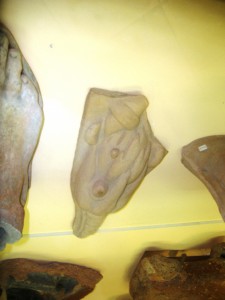Last Sunday’s outing to Cerveteri and its Etruscan necropolis included a visit to the town’s small museum. Where we saw the following terracotta figurine:

The piece wasn’t labeled, and I had to take the photograph at a weird angle through glass, so the quality is not great. But that looks like an artichoke to me, or maybe a cardoon. Unfortunately I wasn’t able to find much on the internet about the Etruscans and the artichoke, but they definitely had it. And it is still a big crop in the region. But I’m just not entirely certain. What do you think?
Nibbles: Bananas, Sorghum, Agave, Big vs small, Cauliflower, Wine, Chestnut, Farmers’ rights, India, Aquaculture, Medicinals, Tarpan
- How they grow bananas in Fadan Karshi, Nigeria.
- How they grow sorghum in Karamoja, Uganda.
- How tequila is ruining small farms in Mexico. Or is it?
- How small farms cannot feed Africa. Or can they? Join the debate! Via.
- How the Brits plan to rebrand cauliflower. This I gotta see.
- How the ancient Chinese made wine out of rice, honey, and fruit. Pass the bottle.
- How Georgia is mapping where its chestnuts used to be.
- How farmers’ rights are being implemented.
- How Indian agriculture should move beyond wheat and rice. Ok, but what would everybody eat?
- How microsatellites can be used to help catfish breeding.
- How Ni Wayan Lilir is helping people learn about the traditional healing herbs of Bali.
- How the Brits brought back the Konik.
Nibbles: Wine, Ass, Maps, Mauka, Pest management, Photos
- Mathilda on domestication of the vine and donkey.
- New software for species mapping is out: Croziat.
- Another day, another tuber.
- Using Diversity as a Pest Management Tool. There’s a thought.
- Pix of West African plants, including cultivated, with lots of assorted link goodness.
Recreational farming
An interesting triptych today on farming as recreation. Kind of, anyway. From Vietnam, an unfortunately rather brief article on how foreign tourists can become farmers for a day at Tra Que village. The piece doesn’t say whether that’s the same Tra Que which is being protected by trademark, but I would guess so. 1
There was also today an article about the Konso of Ethiopia, who are apparently sometimes referred to as “the toughest farmers in Africa.” A so-called eco-lodge has been set up, “whose mission is to tie tourism and community development activism through permaculture together, delivering tangible community benefits.” Again, as in Vietnam, the idea is community immersion, though for longer than just a day, and in rather more difficult circumstance, I expect.
And finally, to the Isabella Freedman Jewish Retreat Center in Falls Village, Connecticut. Actually it’s a bit of a cheek including this with the previous two stories. The people attending the Centre, and others like it, are in earnest about learning to farm in a way that follows the Law: “One-sixth of the Talmud deals with agriculture.†Some, indeed, will take farming up as a profession. But not all: “We don’t all need to be farmers. To have farming be a little part of every Jewish person’s life, that’s our goal.â€
Indigenous Tourism and Biodiversity Website Award
Don’t forget to vote!